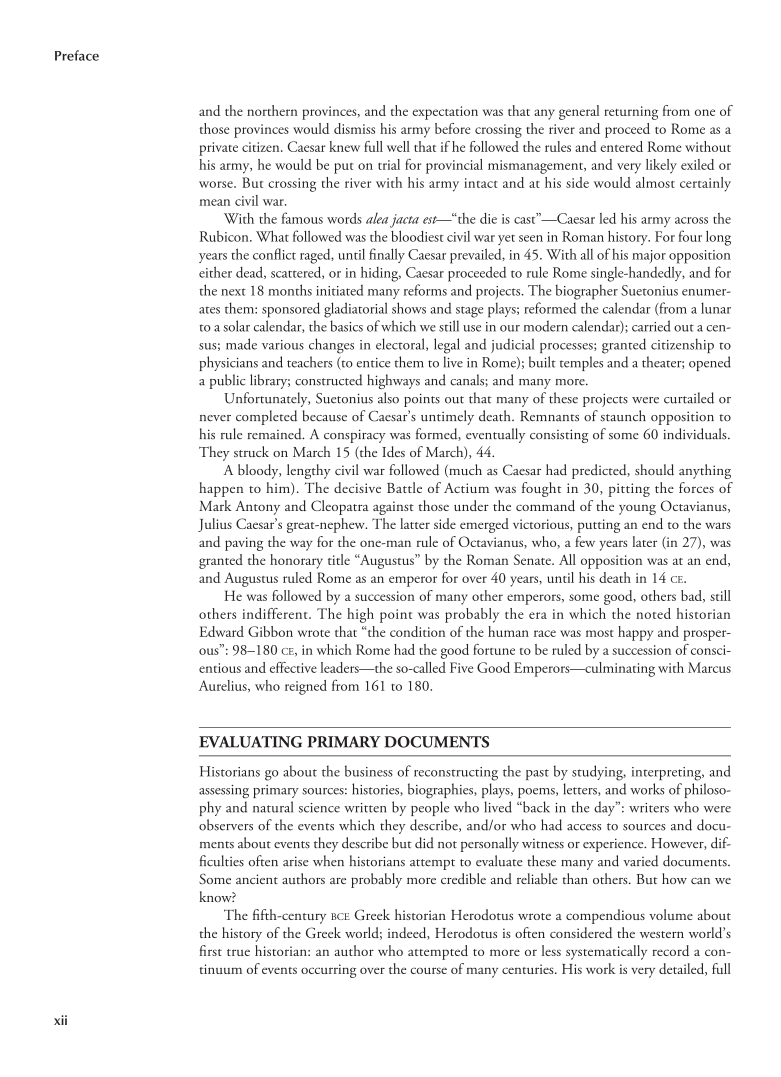and the northern provinces, and the expectation was that any general returning from one of those provinces would dismiss his army before crossing the river and proceed to Rome as a private citizen. Caesar knew full well that if he followed the rules and entered Rome without his army, he would be put on trial for provincial mismanagement, and very likely exiled or worse. But crossing the river with his army intact and at his side would almost certainly mean civil war. With the famous words alea jacta est—“the die is cast”—Caesar led his army across the Rubicon. What followed was the bloodiest civil war yet seen in Roman history. For four long years the conflict raged, until finally Caesar prevailed, in 45. With all of his major opposition either dead, scattered, or in hiding, Caesar proceeded to rule Rome single-handedly, and for the next 18 months initiated many reforms and projects. The biographer Suetonius enumer- ates them: sponsored gladiatorial shows and stage plays reformed the calendar (from a lunar to a solar calendar, the basics of which we still use in our modern calendar) carried out a cen- sus made various changes in electoral, legal and judicial processes granted citizenship to physicians and teachers (to entice them to live in Rome) built temples and a theater opened a public library constructed highways and canals and many more. Unfortunately, Suetonius also points out that many of these projects were curtailed or never completed because of Caesar’s untimely death. Remnants of staunch opposition to his rule remained. A conspiracy was formed, eventually consisting of some 60 individuals. They struck on March 15 (the Ides of March), 44. A bloody, lengthy civil war followed (much as Caesar had predicted, should anything happen to him). The decisive Battle of Actium was fought in 30, pitting the forces of Mark Antony and Cleopatra against those under the command of the young Octavianus, Julius Caesar’s great-nephew. The latter side emerged victorious, putting an end to the wars and paving the way for the one-man rule of Octavianus, who, a few years later (in 27), was granted the honorary title “Augustus” by the Roman Senate. All opposition was at an end, and Augustus ruled Rome as an emperor for over 40 years, until his death in 14 CE. He was followed by a succession of many other emperors, some good, others bad, still others indifferent. The high point was probably the era in which the noted historian Edward Gibbon wrote that “the condition of the human race was most happy and prosper- ous”:98–180 CE, in which Rome had the good fortune to be ruled by a succession of consci- entious and effective leaders—the so-called Five Good Emperors—culminating with Marcus Aurelius, who reigned from 161 to 180. EVALUATING PRIMARY DOCUMENTS Historians go about the business of reconstructing the past by studying, interpreting, and assessing primary sources: histories, biographies, plays, poems, letters, and works of philoso- phy and natural science written by people who lived “back in the day”: writers who were observers of the events which they describe, and/or who had access to sources and docu- ments about events they describe but did not personally witness or experience. However, dif- ficulties often arise when historians attempt to evaluate these many and varied documents. Some ancient authors are probably more credible and reliable than others. But how can we know? The fifth-century BCE Greek historian Herodotus wrote a compendious volume about the history of the Greek world indeed, Herodotus is often considered the western world’s first true historian: an author who attempted to more or less systematically record a con- tinuum of events occurring over the course of many centuries. His work is very detailed, full Preface xii
Document Details My Account Print multiple pages
Print
You have printed 0 times in the last 24 hours.
Your print count will reset on at .
You may print 0 more time(s) before then.
You may print a maximum of 0 pages at a time.










































































































































































































































































































